New Japan Pro Wrestling had been resurrected. Blame it on an economic bubble bursting, MMA on the rise, or Inokism squandering talent; NJPW was on the brink of bankruptcy for a period of time after the turn of the 21st century. Under new management starting in 2006, the company saved itself through a shift in philosophy and making new stars.
Tanahashi, Okada, and the Golden Age
Hiroshi Tanahashi became the Ace. Shinsuke Nakamura, his second in command. The lost Third Generation (Yuji Nagata, Satoshi Kojima, Hiroyoshi Tenzan) were rehabilitated. A supporting cast of Hirooki Goto, Togi Makabe, and Toru Yano elevated. And the first five years of Wrestle Kingdom proved that their pro wrestlers were the best in Japan. Where then does New Japan go after the fight for survival is won? From rebirth to renaissance.
Wrestle Kingdom 6
Tanahashi, Okada, and the Golden Age

January 4, 2012: Hiroshi Tanahashi has been IWGP Heavyweight Champion for 365 days. He is in his fifth reign with a milestone 10 defenses. Across from him is Minoru Suzuki, a freelancer who has returned to New Japan and wrought havoc on its roster for the past year. It’s a classic 25-minute bout between good and evil.
Suzuki is the perfect villain as he pulls demon-like faces, taunts the crowd, and breaks the rules. Tanahashi is the perfect hero as he throws caution to the wind and lays it all on the line to fight back from utter defeat. The Ace prevails, improving his Wrestle Kingdom record to 5-1, as he rings in the new year with the new record for title defenses.
While the current king jams out on air guitar to close the show, the semi-main saw past meet future when Tetsuya Naito took on his childhood idol Keiji Muto. Naito had come up the ranks throughout the post-Inoki era: serving as a Young Lion at ringside, being a Junior Heavyweight, becoming tag team champion, going on excursions to TNA and CMLL. He would pick up a few breakout victories here and there and even made the finals of the previous year’s G1 Climax in a losing effort.
But Muto was a brick wall to the high-flying, rising star. The legend grappled with him on the ground but the kid could hang. Muto worked over the knee but the kid didn’t quit. Naito made a spirited showing against the main event icon he hoped to one day replace, but was pinned after the Moonsault.

The top of the card was filled out with good matches for the supporting players. Shinsuke Nakamura had fully adopted the persona that made him famous: the outfit, shaving the side of his head, and showing more charisma in his hands than some men ever do in their careers. He was leader of the Chaos stable, with Nakamura bringing the cool and Toru Yano bringing the heel. They lost to visiting NOAH wrestlers Go Shiozaki and Naomichi Marufuji.
New Japan vs the World continued throughout the night. Togi Makabe beat Yoshihiro Takayama in a short sprint of stiff striking. Hirooki Goto beat Takashi Sugiura in their annual battle between decorated also-rans of their respective companies. And the team of Tenzan and Kojima (Tencozy) beat Giant Bernard and Karl Anderson to win the IWGP Tag titles and end the Gaijin team’s massive reign.
However, one of the most important results was a 4-minute match early in the card. Kazuchika Okada was making his return to NJPW after an excursion to TNA. And he looked like someone doing an Okada cosplay. A little too tan, a little too round-faced, the hair wasn’t right. He had the costume and the moniker, but not the Rainmaker charisma.
Okada was beat down bell to bell, aside from a couple beautiful dropkicks, and he hit his finish that is more like a neck breaker than the killer lariat. Not impressive in the least. Which made it all the more intriguing when after the main event, Okada challenged Tanahashi for the title amidst boos from the crowd.
Kazuchika Okada in 2012
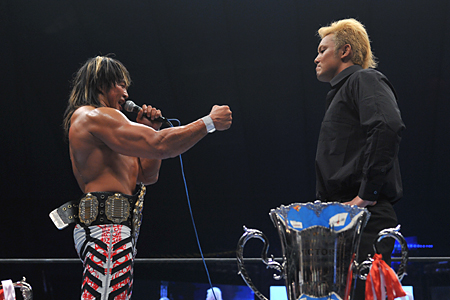
In one corner stood the IWGP Heavyweight champion, the Ace of the New Japan who for the past three years has brought business back. In the other corner was a 24 year old who the audience hadn’t seen in a year while he was being someone’s goofy sidekick in America. In the Wrestling Observer Newsletter, Dave Meltzer suggested that Tanahashi was a 4+ star ring general but would be “hard-pressed” in carrying Okada for their title match.
For his 2011 reign, Tanahashi was voted WON’s Wrestler of the Year and was the first Japanese star to win since Kenta Kobashi in 2005. So on February 12th 2012 when a young Kazuchika Okada beat him for the title, it was a questionable surprise. The kid had purple hair and put his foot on Tanahashi’s chest after the match. Although NJPW had been sold from Yuke’s to Bushiroad some two weeks prior, this change was said to have been from the old regime.
Meltzer was high on Tanahashi as a draw and low on Okada as a poor man’s Ric Flair gimmick who needed Gedo as his mouthpiece. Bryan Alvarez in Figure Four Weekly was open to seeing this “huge gamble” play out in time. Okada defeated Naito at the 40th-anniversary show in March and Goto in May for two excellent defenses. He dropped the title back to Tanahashi in June and later won the G1 Climax. A main eventer had been born.
Wrestle Kingdom 7
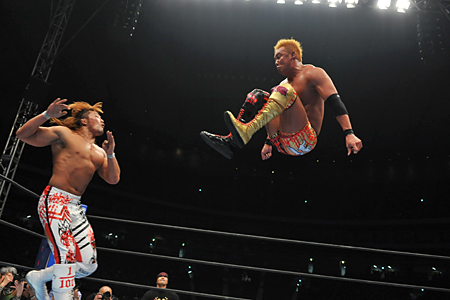
January 4, 2013: for the first time ever, Wrestle Kingdom was made available as an Internet PPV. And for the first time in a while, the company doesn’t artificially inflate the attendance, putting up a respectable 29,000 paid. While other companies outside of WWE were on the downturn, the hype for New Japan was real.
With only a few multi-man tags to open the show, the bulk of the card was all killer. Masato Tanaka defended the newly formed NEVER Openweight title, intended to showcase young or unsigned talent, against Shelton Benjamin. The villainous Suzuki-gun stable defended the IWGP tag belts when Lance Archer and Davey Boy Smith Jr.
(Killer Elite Squad) defeated Goto and Karl Anderson. And in a great match, Nagata defeated Suzuki in their Wrestle Kingdom rubber match, proving that the 44-year-old Ace-that-never-was still had something left in the tank.
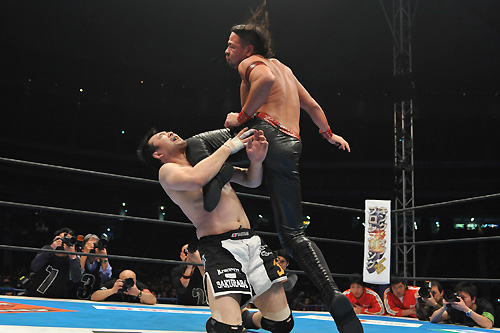
The middle of the show saw a return to form. In the 90s, Jushin Thunder Liger and the Super J-Cup scene helped define a new era of cruiserweight wrestling. And for the preceding few years, the IWGP Junior Heavyweight championship lineage was once again a list of inspiration for the next generation of wrestlers: Low-Ki, Mistico, Marufuji, Prince Devitt, and Kota Ibushi.
In a nonstop threeway where one crazy spot flowed into the next, Devitt retained over Ibushi and Low-Ki, calling back to Wrestle Kingdom V where Devitt retained over DDT’s Ibushi, accompanied by Kenny Omega.
Tencozy scored the win over Keiji Muto and Shinjiro Otani when Otani was pinned by Tenzan. Otani was a fellow defector from New Japan, leaving in 2001 to launch the Zero1 promotion with Shinya Hashimoto. In another blast from the past, Togi Makabe took on Katsuyori Shibata in an absolute brawl. Shibata had left New Japan in 2005 to pursue MMA and returned late last year causing havoc.
They fought before the bell and didn’t care much for moves other than taking the other’s head off. Makabe won, defending the honor of puroresu. Likewise, Shibata’s ally Kazushi Sakuraba was defeated by Nakamura in the semi-main to retain the Intercontinental title, in an MMA-style match to help put the new belt on the map.
In the main event, Tanahashi and Okada brought their year-long story to a close in an incredible title bout. Evenly matched at first, a distraction by Gedo allowed Okada to take over with his innovative submissions. Tanahashi played the persevering babyface, at one point refusing to win by count out when he laid out the challenger on the ramp. They kicked into a raucous third gear when Okada shockingly kicked out of the High Fly Flow.
It wasn’t a double turn, but Okada valiantly fought out of a deep Texas Cloverleaf submission, growing up from cocky little shit to respectable combatant right before the crowd’s eyes, as he had for the previous 365 days. Yet Tanahashi was victorious, closing out the Tokyo Dome with another air guitar performance and one more “I Love You!”
Bushiroad’s NJPW in 2013

The purchase of NJPW by Bushiroad proved to be successful, or at least they were reaping the rewards of the previous 5 years. The Wrestling Observer Newsletter hadn’t rated a match in Japan 5 stars during the late 2000s dark age, which changed in October 2012 when Tanahashi faced Suzuki for their first international PPV. The flood of 5 star New Japan matches erupted after that point. In the Tokyo Sports Awards, they started running the table on MVP and Best Bout voting for years to come.
It’s curious, then, when Takaaki Kidani (Founder and President of Bushiroad) resigned as New Japan chairman the day after Wrestle Kingdom 7. Certain questions lingered, such as Kidani bringing in Shibata and Sakuraba to lead an MMA invasion without the bookers’ knowledge beforehand. They were defeated at the Tokyo Dome anyway, putting an end to that story before it started.
At the same time, there was a debate to be had over the main event. At the time, Bryan Alvarez sensed a feeling of disappointment and a “head-scratcher”, writing in Figure 4 Weekly that people were hoping Okada would be crowned as the new Ace.
The other school of thought, as Dave Meltzer noted, was that if business was growing with 36-year-old Tanahashi on top, you don’t make the change. The conclusion was that Kidani was stepping away from wrestling operations because New Japan had become popular enough to run on its own.
By February, Chaos was at war with Suzuki-gun and Okada found his alignment shifting in the eyes of the fans. His aura was so hot that WWE even made an offer, though he signed a one year extension with NJPW. He would lose to the villainous Minoru Suzuki, but rebounded to win the New Japan Cup in March and the IWGP Heavyweight title in April for his first 5-star match.
The Rainmaker shock of 2012 wasn’t just a flash in the pan, Okada cemented his spot in 2013. Perhaps now, the Once in a Century talent Tanahashi could rest easy sharing the crown with someone else. Perhaps not.
Wrestle Kingdom 8
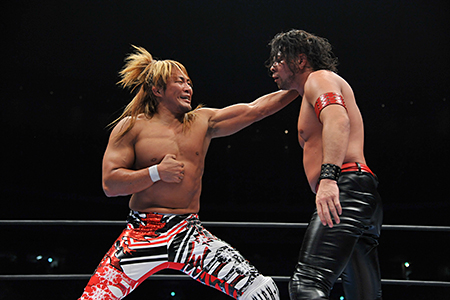
January 4, 2014: Times were turbulent for NJPW. The opening match saw the Young Bucks defend their IWGP Junior Heavyweight Tag Titles in a four-way match of non-stop action against Time Splitters (Alex Shelly and Kushida), Forever Hooligans (Alex Kozlov and Rocky Romero) and Suzuki-gun (Taka Michinoku and Taichi). Bullet Club had formed the previous spring and brought in the Bucks that fall to win the Junior Tag League and the titles. In the next match, Karl Anderson and Doc Gallows beat Killer Elite Squad to give Bullet Club the IWGP tag belts.
As Bullet Club rose in 2013, New Japan experienced something of a decline as well. That summer’s G1 Climax, while producing some legendary matches, left some participants hurting: physically and booking-wise. The honeymoon period of the new era was over late that year. The middle of Wrestle Kingdom 8 saw Kojima beat Rob Conway for the NWA title in a limited match. Nagata and Sakuraba won via DQ over Daniel and Rolles Gracie when Nagata was illegally choked out; a clunky flashback to the dark age of puroresu vs MMA.
The next match saw two capable wrestlers in Suzuki and Shelton Benjamin take on gimmick wrestlers Toru Yano and The Great Muta. With grand entrances, outside brawling, and interference, it was nothing special. Suzuki got rolled up by Yano after a low blow and mist by Muta. Following that was another plodding match between Togi Makabe and Bullet Club’s underboss Bad Luck Fale. There’s always some drama to a last man standing match, but Makabe got the victory and once again defended the honor of New Japan.
As per usual, the top matches of Wrestle Kingdom were what carried the brand. Throughout 2013, Shibata and Goto had three matches, two ending in a double knockout and one win for Shibata. Before they could meet again in the G1, Goto suffered a broken jaw that kept him sidelined for the rest of the year. Now he was making his return against a knockout artist.
Their relationship went back to their days as high school classmates, continuing when Shibata abandoned pro wrestling and Goto had to serve in his place as a New Musketeer alongside Tanahashi and Nakamura to save NJPW. Their bout was exciting and hard hitting, and when Goto finally got his win, only then could they leave the ring arm in arm as friends.
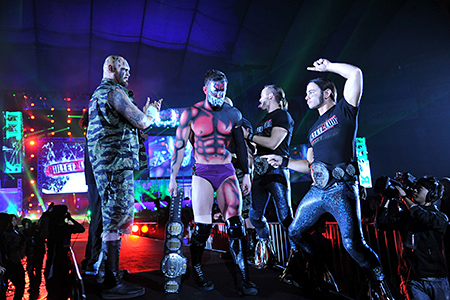
Longtime rivals Prince Devitt and Kota Ibushi each shook up the industry in 2013. Devitt turned heel on his partner Ryusuke Taguchi and formed Bullet Club, bringing Western-style swagger and gang warfare. Ibushi bulked up to heavyweight, had some spectacular performances in the G1, and soon after signed a dual contract between DDT and NJPW.
With Devitt defending his Junior Heavyweight championship, Bullet Club goons interfered at every opportunity until they were thrown out. Ibushi fought through every obstacle, learned from his past mistakes against Devitt at Wrestle Kingdoms, and won the title: for his third time, but more importantly breaking his January 4th curse against his rival.
For as legendary a summer they had in 2013, the honeymoon phase had to end. When G1 winner Naito stood opposite Okada at the November show Power Struggle, the people who weren’t booing were silent. Naito, who had been gone for 8 months since October 2012, who went 5-4 in the G1 and advanced to the finals via tiebreakers, who had been chasing the third rate Never title, had declared himself to the crowd as the protagonist of NJPW.
Okada hadn’t had an impressive G1 either, but at least he put on another 5 star match with Tanahashi in October. Okada and Tanahashi was a hot rivalry. Okada and Naito from March 2012 had been a hot match. This November night was cold. A few days later, management put it to a fan vote, determining which match would main event the Tokyo Dome. The result was 63%-37% in favor of Nakamura vs Tanahashi for the Intercontinental title.
In the semi-main, Okada came out to defend the IWGP title against Naito. It was a half hour, slow-build epic yet the real drama was in the subtext. Naito fought as the underdog, as if he were battling the expectations/failings to become that top level star. Okada laid him out on the outside twice and waited inside the ring for him to beat the twenty count.
If he respected his opponent he would throw him inside to finish it with honor. Naito had to scratch and crawl for his spot. At one point Okada dared Naito to throw harder forearms, so Naito responded with enraged headbutts. The Rainmaker was victorious in a spirited finish, but it’s the overall failure of the Stardust Genius that people will remember.
On the other side of the coin was the pairing fans wanted to see in the main event. Tanahashi, coming off a 30 min draw with champion Okada in the G1, making the finals, and another 5 star match in October. Nakamura who, with the exception of a month-and-a-half period, has been Intercontinental champion since July 2012. With Stan Hansen presiding, perhaps it was prescient that the fans honored the history of these generational rivals.
It was their third time main eventing the January 4th show (2005, 2008) and with the mounting injuries, physical style, and the march of time, it was perhaps their last chance for a final dance at this level on this grand a stage. Tanahashi won the IC belt, reminding the 35,000 in the Tokyo Dome that the Ace doesn’t lose at Wrestle Kingdom.
Bullet Club in 2014

On April 6th, 2014 the pro wrestling landscape shook on both sides of the world. At Wrestlemania 30, the Undertaker’s streak was broken and Daniel Bryan became the people’s world champion. At NJPW’s Invasion Attack, Prince Devitt was kicked out of Bullet Club (leaving for NXT) and AJ Styles debuted to challenge Okada.
Styles had been one of the best American wrestlers for about 10 years. Yet his tenure in TNA made him a big fish in a small pond. His performances were always phenomenal in the ring, but the ups and downs of TNA booking would lead him towards the exit. In his first match with New Japan, Styles defeated Okada amidst copious Bullet Club interference to join an exclusive club of foreign wrestlers to hold the IWGP title.
The arrival of a world-class top guy was more than welcome in this period. Naito’s star had fallen as he lost the Never title in front of a booing crowd: albeit in a great match against Tomohiro Ishii. Soon after, Yujiro Takahashi turned heel and won the belt from Ishii. Bad Luck Fale made the New Japan Cup Finals and would win the Intercontinental title.
Bullet Club itself had more than doubled in size from its original incarnation and continued to grow: even Jeff Jarrett joined at this point. Not to blame their Western-style chicanery, but NJPW in 2014 only had one WON-rated 5-star match, a noticeable dip in the trend. By June, Meltzer wasn’t ringing the alarm per se, but he did emphasize that Nakamura and Tanahashi couldn’t be on top forever.
As if his prayers were answered, the 2014 G1 Climax recaptured some of the magic from last year’s tournament. Even without an injured Kota Ibushi, the two blocks were able to put on all-star matchups on any given night. AJ Styles vs Minoru Suzuki in front of a packed Korakuen Hall was voted by WON subscribers as their match of the year. Shibata, Tanahashi, even Nagata had people jumping out of their seats. The Finals saw the rare pairing of Okada against Nakamura, with the Rainmaker winning a spot in the Tokyo Dome main event for the second time.
After Tanahashi beat Styles for third place in the G1, the reign of the Phenomenal One would end in October, returning the IWGP title to the Ace. It was a match full of western influence: ref bumps, Yoshi Tatsu’s surprise debut run-in off his WWE run, and Jeff Jarrett being the most southern heel. For all the shenanigans Bullet Club brought, the quality of wrestling improved with AJ as a star, along with an influx of ROH talent.
Wrestle Kingdom 9

January 4, 2015: With the announcement of an AXS TV deal and the launching of their own streaming service, New Japan started the year hot. The Tokyo Dome main card continued the new tradition of the all-action tag team four-way. Kyle O’Reilly and Bobby Fish defended their Junior Heavyweight titles against Time Splitters, Forever Hooligans, and the Young Bucks.
The old guard of Honma, Kojima, and Tenzan defeated the Bullet Club riff raff: Jeff Jarrett representing GFW, Fale representing his failed main event push, and Yujiro representing the pimps. Toru Yano received help from Marifuji and TMDK to defeat the Suzuki-gun minions, inciting an invasion of NOAH that would see Suzuki and his army on the green brand for the next two years.
The middle of the card formed a neat buffet of different tastes. Minoru Suzuki defeated Sakuraba in a shoot style dream match. Makabe defeated Ishii for the Never title in an excellent match, proving there’s more than one way for two grizzled old men to hit each other as hard as they can. Kenny Omega made his NJPW debut, winning the Junior Heavyweight title from Ryusuke Taguchi using Bullet Club tactics. And high school friends Goto and Shibata defeated Gallows and Anderson to end their 1 year reign as tag champs.
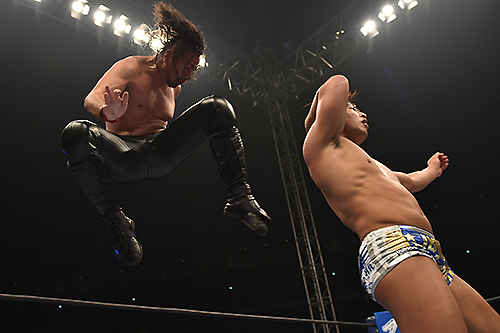
However, the top matches are what Wrestle Kingdom is all about. Naito lost yet again to put over AJ Styles as the next IWGP challenger. In the semi-main, Nakamura defended the Intercontinental title in a classic match against Ibushi. It was a redux of their 2013 G1 bout where the young guy gave the veteran all he could handle and more. Meltzer rated it 5 stars and WON subscribers would go on to vote it Match of the Year.
Capping off a night of great wrestling, Tanahashi was set to defend his belt against Okada for the second time on January 4th. The Rainmaker was angry and aggressive. No longer was he that 24-year-old kid who caught everybody by surprise in 2012. He felt like he’d earned his chance to be Ace and was ready to take it if necessary.
Tanahashi, however, had raised the bar. He turned the tables on the challenger, including a crazy High Fly Flow from the top rope beyond the barricade. After a fantastic bout, the champion retained.
Okada was weeping bitterly as Gedo helped him to the back. He collapsed to his hands and knees in distress as the crowd chanted his name. Like any athlete, making the championship game is hard. To fail is even harder. The IWGP title was that important. Wrestle Kingdom was special. Long-term storytelling had the audience looking forward to one specific date. Tanahashi beat him twice on January 4th. Okada had to finish the story.
Tetsuya Naito in 2015
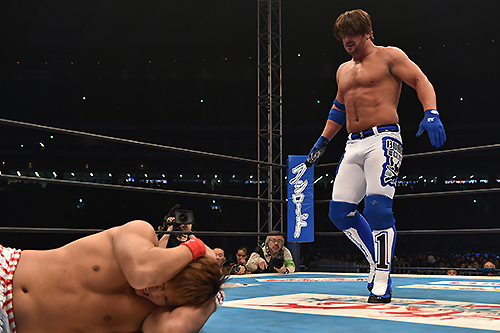
January 4th had not been kind to Tetsuya Naito. He’d lost every single time except for one tag match early in his career. The fan vote debacle did no favors to his standing in the field. Meanwhile, AJ Styles had won back the IWGP title in February, Kota Ibushi won the New Japan Cup in March, and Kenny Omega was reigning strong as Junior Heavyweight champion.
After a joint show with ROH in America where Naito failed to win their TV title, he went down to Mexico to catch up with an old friend. La Sombra had been his tag partner in the previous two Tag Leagues and inducted the Stardust Genius into Los Ingobernables to learn the way of the rudo. When he returned to Japan shortly before the G1, Naito was different. He was slow in walking to the ring. He wore a t-shirt in the ring when he could. He looked like he hadn’t shaved.
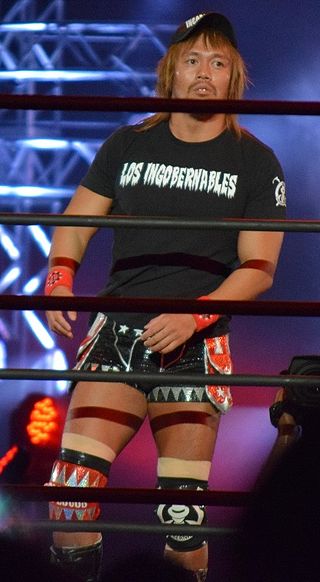
Naito was tranquilo. He made his entrance in a mask and a three-piece suit, making his opponent wait while he disrobed in the ring. For a company and culture that values working hard and doing your best, he had turned his back on the crowd. His bare minimum effort still led him near the top of his Block with a 5-4 record, but wasn’t good enough to advance.
If the fans didn’t respect him as a high-flying young babyface before, then why destroy his body and his knees for nothing? One might say he refused to be controlled. Ungovernable, even.
Although he didn’t win the Tokyo Dome main event briefcase, or beat the winner Tanahashi when given the chance, Naito gained something of significant value. A young lion returning from excursion joined him, called EVIL. A junior heavyweight joined their team, called Bushi. After being rejected by the fans, he was accepted by his own band of misfits. And thus, Los Ingobernables de Japon was born.
Wrestle Kingdom 10
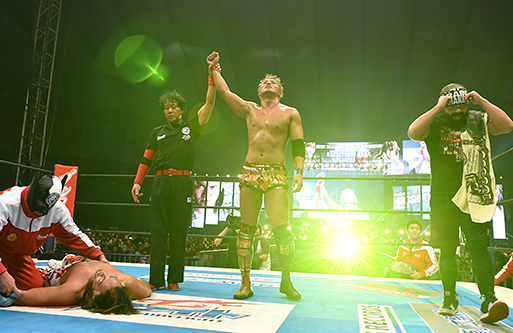
January 4, 2016: If anything signaled the changing of an era, it was the use of Nagata, Kojima, and Tenzan in the pre-show Rumble. The Third Generation of the New Japan Dojo, lost to the dark ages of the early 2000s, have aged into good-hand territory.
The main card kicked off with the Young Bucks reclaiming the Junior Tag titles from Kyle O’Reilly and Bobby Fish, Matt Sydal and Ricochet, and Roppongi Vice (Rocky Romero and Trent Berretta). There’s no going wrong with a hot opener where the crowd isn’t given the downtime to become bored.
Next was a bout to crown the first Never Openweight 6-man champions. Bullet Club members Bad Luck Fale, Tama Tonga, and Yujiro Takahashi came out with a beautiful dancing woman. Toru Yano came out with his partners, Jay and Mark Briscoe. The number of title belts had essentially doubled in the past few years, but seeing the Briscoe Brothers go wild is always fun.
And in other news, Jay Lethal defeated Michael Elgin to retain the ROH title. If the one guy heard chanting ROH is any sign, the partnership (among other factors) had helped facilitate their exposure to the west and even brought visitors to Japan.
The middle portion of the show kicked off with Omega vs Kushida for the Junior Heavyweight title. Except for an 80 day reign from Kushida, Omega had held the belt since last Wrestle Kingdom. The match began with copious amounts of weapons and interference from the Bucks, but gave way to a hot little match brewing. Kushida won back the championship, giving him the January 4th seal of approval that after years of working his way up the division, he just might be the next Jushin Thunder Liger.
For the third year in a row, Anderson and Gallows were involved in the tag title match, this time defending the belts. Because of the pervasiveness of Bullet Club and the limited division, they became synonymous with the scene, much like the Bucks in their own weight class. In an exciting battle, they lost to Togi Makabe and Tomoaki Honma, two tough-as-nails workhorses on the roster. Fan favorite Honma had won his first taste of gold.
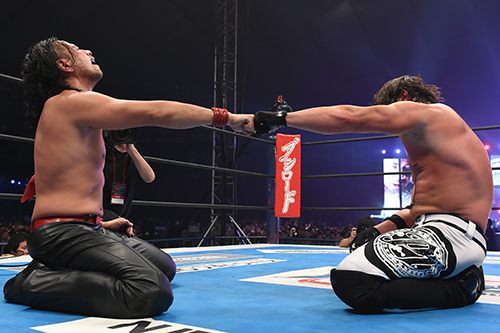
Rounding out the middle portion of the 12-minute samplers was Hirooki Goto vs Tetsuya Naito. With interference from Bushi and Evil, and the constant accosting of the referee and cameramen, Naito had fully embraced his heel persona. He lost, as per usual for the date. But his complete character reinvention from a year ago was remarkable, and even some fans in the crowd were starting to become fans of his devil-may-care attitude.
The top-of-the-card matches began with Tomohiro Ishii defending the Never title against Katsuyori Shibata. Ishii had traded the belt with Makabe over the past year, giving the tertiary title some identity as the hardest-hitting division in New Japan. And the match lived up to the hype, as the two took turns hitting each other with different strikes.
If you’re going to pick a single lane, why not perfect it? They hit some brutal, skull-on-skull headbutts which was a gnarly scene. Shibata earned the victory, continuing his redemption arc from the man who left the company to holding singles gold.
In the semi-main, a first-time dream match saw AJ Styles challenging for Nakamura’s Intercontinental championship. And they left it all on the dance floor. Stiff strikes. Submission work. Nakamura kicked out of the Styles Clash. The champion retained in a fantastic match.
Perhaps why both men gave it their all was the fact that earlier that day they had each given their notice to the company and would be signing with WWE by the end of January, part of the initiative to suppress the rising tides of NJPW and ROH.
And in the main event, Tanahashi challenged Okada for the IWGP title. It’s the longest of their Wrestle Kingdom trilogy at 36 minutes with all the gravitas of the 4 years they’ve been against one another. Tanahashi targeted the lower body of Okada, reminding him that his own knees were shot from carrying the company for 10 years.
Okada, on the other hand, decided to innovate his offense to survive. He learned from the man he hoped to replace: using aerial maneuvers, diving over the barricade, even hitting the High Fly Flow. But at the end of the bout, it was a series of Rainmakers that delivered the victory for Okada. For the first time in 8 years, Tanahashi lost on January 4th. Because the Ace doesn’t lose at Wrestle Kingdom.
Epilogue

Following the rebirth period from Wrestle Kingdom 1 to Wrestle Kingdom 5, New Japan Pro Wrestling experienced a golden age from Wrestle Kingdom 6 to Wrestle Kingdom 10. It was an era where over a dozen top-level, unique wrestlers could pair off and put on world-class matches.
Not only was the biggest show of the year a guaranteed hit, but now every month was something special, even a few nights a week during the G1 Climax. And all of it was more and more available around the world thanks to TV deals, NJPW World, and the Internet buzz of the early 2010s.
This time period evolved into a different scene in early 2016. Okada was now Ace. Tanahashi was about to turn 40. Nakamura and Styles were gone. By February, Ibushi left to go freelance. But as history teaches us: when the old stars leave, new stars must take their place.
Perhaps it would be new Bullet Club leader Kenny Omega. Or the leader of Los Ingobernables de Japon, Tetsuya Naito. With the next generation on the horizon, everything was looking up. Ten years ago, NJPW was at the bottom. Ten years later, they became the gold standard of professional wrestling excellence.










